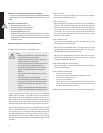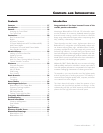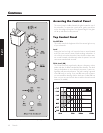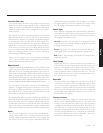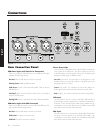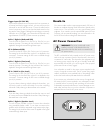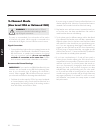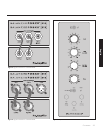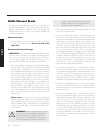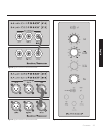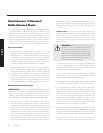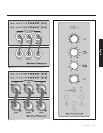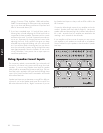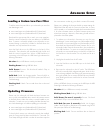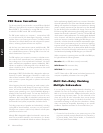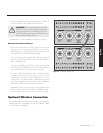
24 Connections
Multi-Channel Mode
This setup is recommended if you will use your subwoofer in a
dedicated home theater or other multi-channel system. When a
signal is connected to the subwoofer’s LFE In, the setting for the
Low-Pass Filter control is not used. Your processor handles most
of the bass management.
Signal Connection:
1 Connect the LFE out of the processor to the LFE In. Use either
an RCA or an XLR interconnect—do not use both at the
same time.
Recommended Control Settings:
IMPORTANT! If you intend to use PBK (Perfect Bass Kit) room
correction we recommend running PBK and optimizing place-
ment of your subwoofer prior to adjusting the subwoofer’s
controls. When engaged, PBK will affect the acoustic output of
your subwoofer and influence the settings described below.
1 If your front speakers are large (e.g. full-range floorstanding
type speakers) set your processor controls for front speakers
to wide, large, or full mode. If your front speakers are small
(e.g. bookshelf type speakers) set your processor control for
front speakers to narrow, small, or limited mode. Set proces-
sor controls for center and effects type speakers to narrow,
small, or limited mode. Remember, few center and effects
type speakers are designed to go much lower than 70Hz,
which means that any bass information in a soundtrack lower
than this frequency will normally be lost. When you set your
center and effects type speakers to narrow, small, or limit-
ed mode, all of the bass lower than the assigned crossover
point will be redirected to the subwoofer along with the LFE
output—guaranteeing that no bass information from these
channels is lost.
Please note: some processors allow the changing of
speaker configuration based on source material type. Under
these conditions the user may want to run the fronts in narrow,
small, or limited mode for multi-channel source material and
run the fronts in wide, large, or full mode for 2-channel stereo
source material.
WARNING! Based on the performance of most
processors it is recommended that MartinLogan
center and effects type speakers not be run in
large, wide, or full range mode. Doing so may
potentially damage the speaker if the processor
attempts to drive the speaker beyond its rated
frequency range. This warning also applies to
products from other manufacturers.
2 With multi-channel source material playing, adjust the Level
control to your preferred level.
3 Adjust the Low-Pass Filter setting to the same frequency as
the crossover setting being used in your processor (although
this may seem redundant, it actually optimizes effectiveness
of the phase control). Try the phase control in different set-
tings until the best blending is obtained. Play familiar music
with deep, repetitive bass. Adjust the phase control so the
bass notes seem their loudest and without blur when heard
from your typical listening position. If you are augmenting
MartinLogan loudspeakers, we suggest you start with Phase
set at 0° (although we suggest 90° elsewhere, in this specific
connection method we suggest 0° since your processor will
be doing most of the bass management). If you are using
a Custom Low-Pass filter, we also suggest you start with the
Phase set at 0°. Custom Low-Pass filters provided for these
subwoofers are already phase optimized.
4 If you have completed steps 1–3 and still have weak or
booming bass consider adjusting the 25Hz Level knob to
compensate for these anomalies. Experiment with the controls
and listen to the result. Try to find a position that sounds cor-
rect to you. Experiment by changing the Level control while
adjusting these knobs. Find a position that gives you deep
extended bass and good blending with your main speakers.
5 Use the bass management section of your processor’s speak-
er setup to set the subwoofer level at an appropriate level.
Follow the instructions in your processor’s manual to fine-tune
the subwoofer level.
6 If you have completed steps 1–5 and still have weak or
booming bass consider adjusting the 25Hz Level knob to
compensate for these anomalies. Experiment with the controls
and listen to the result. Try to find a position that sounds cor-
rect to you. Experiment by changing the Level control while
adjusting this knob. Find a position that gives you deep
extended bass and good blending with your main speak-
ers. If you still have weak or booming bass you may want to
consider moving your subwoofer and go through these setup
steps again (especially if it is located in or near a room cor-
ner). Remember, room position has a major impact on overall
bass performance.
English



